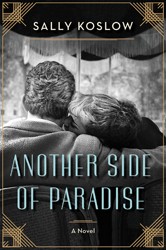In 1947, Holocaust survivor Yitzhak Goldah arrives in Savannah, Georgia to start a new life with his American cousin Abe Jesler and Abe’s wife, Pearl. The generous Southern Jewish couple open their home to the exhausted Goldah and provide him with a job at their shoe store. The Jeslers’ friends are eager to meet Goldah, and he is struck by the contrast between the genteel life in Savannah and the brutal depravity he has just survived in Europe. The Czech refugee is grateful but often stunned into silence.
As Among the Living develops, readers, along with the Jeslers, will hope that Goldah grabs the opportunity to settle into the Jewish community in Savannah. But the survivor must make his own way, and those around him together must also figure out how to coexist. The Savannah characters are still in the process of discovering the details of horrors of World War II. For Goldah, the war is a sensitive subject that he does not wish to define him. Hauntingly descriptive scenes graphically tell his experience. At times the character of Goldah comes across as quiet and befuddled, but at other times it appears that he actually sees the society of Savannah more clearly than the residents. The local rabbi refers to him as “the strongest among us.” Those around him and Goldah himself are unsure about how to discuss the abuse and shame of his gruesome past.
This discomfort increases as Goldah takes up with a widow who is a member of the Reform Temple; the Jeslers themselves belong to the Conservative synagogue. Tensions rise when the two congregations decide to hold Tashlich services on the same beach. Goldah’s absorption into society is further disrupted by the appearance of his fragile fiancée, who he thought had perished. Crushed by her physical and emotional humiliations, she holds nothing but disdain for the Savannah Jews.
The Jim Crow backdrop and the experiences of the Jeslers’ black employees add a further layer of complexity to Rabb’s picture of the social dynamic of the time. A black employee explains the situation to Golda after his son is viciously attacked: “Here they kill us one at a time and that’s the difference.” Other political issues are also addressed; it seems that some of Savannah’s Jews are quietly showing support for the development of the nascent state of Israel, and the Jesler’s rabbi calls the Haganah “our own Minutemen.” Everyday interactions also add moments of levity, such as when a black maid admits she makes the food for a Jewish family taste so good by adding lard.
In the end, Among The Living is a love story depicting how people so hurt can possibly heal and move on. Beneath the gentility, trouble boils.
Related Content:
Dina Weinstein is a Richmond, Virginia-based writer.




